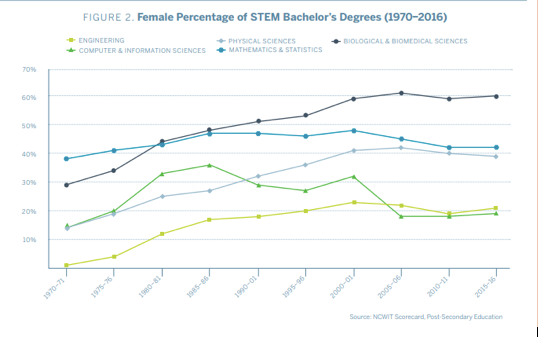
With the recent launch of the SpaceX Crew Dragon, unprecedented advances in science and technology can be seen around us. Despite the advancements and innovations across different mediums, there are still areas that have not made substantial progress. The gender gap in the tech industry is one such aspect where little progress has been made over the years.
Currently, women account for 25 percent of the total workforce in computer-science related jobs. The tech industry is dominated by men and is less accommodating for women than it had been even in the 60s.
In the 1950s, women played a pivotal role in the tech industry with female programmers accounting for 30 percent of the total workforce. At the time, men usually specialised in hardware engineering — building circuits and machinery — while software was built by women. The former was seen as manly, while the latter was seen to be plug-and-chugging with little requirement for intellectual ability. However, in the late 1960s and through the 70s and 80s, that began to change.
Employers began comparing programming less to clerical work and more to masculine activities such as playing chess. Still, the number of women pursuing computer science studies continued to rise during the 70s and early 80s due to booming demand. It reached 37 percent by 1984, and then abruptly flattened. It never caught up since then.
In 2013, the proportion of women in tech roles went down to 26 percent and remained stagnant thereafter. Interestingly, while the number of women graduating with degrees in STEM subjects has increased since the 80s, the percentage of women graduating in computer sciences and engineering technology has been hovering at 19 percent. Further, today women only comprise 25–26 percent of the total workforce in tech roles.
But what changed in the 1980s that caused this gender gap to the extent that we still have not been able to fill it?
For starters, Math puzzles and personality tests were instituted for hiring purposes that gave men an advantage. During the 80s, a higher percentage of men received formal education and therefore, found it easy to solve them.
Additionally, the necessary personality traits in the tests for programmers were similar to traits of white-collar professionals, who were predominantly men at the time. Such profiles slowly cemented the development of a tech professional’s existing stereotype.
Media also played an important role in further increasing this gender gap. In the 1980s home computers began being projected as “boys toys”, which can be seen as a factor that generated more interest in this field among men from a young age. Further, women’s hiring was subconsciously discouraged as misogynistic advertisements against women in the industry started pervading onto televisions and newspapers.
One tagline for Optical Scanning Corporation actually ran, “What has sixteen legs, eight waggly tongues and costs you at least $40,000 a year? Your team of eight female programmers, that’s what.”
Percentage of women graduating from select STEM undergraduate degrees (1970–2016)

With the awareness of this gender disparity becoming a more-talked about issue in recent years, companies often blame ‘The Pipeline Problem’ for not having an equal number of men and women in this field.
‘The Pipeline Problem’ is the assumption that there are not enough minorities and females graduating with degrees in the STEM sector. This, in turn, causes stress on the pipeline at the entry-level stage. With not enough women graduating in STEM subjects, there is also a limitation on the number of women in tech.
But is this actually true?
Research indicates that while the number of women graduating with STEM degrees is growing steadily (1990–2019), the proportion of women graduating in computer science, engineering, and technology is staying steady at 19 percent.
Organisations tend to complain that the talent pool is simply too limited. While there seems to be some reality to the issue of the pipeline, it seems to be a fallacy to the arguments that this is the sole aspect for gender disparity in the industry.
The reality is that while a small pipeline presents a difficulty, the real problem is actually its leaky nature. Based on a survey, 80 percent of women in tech roles said that they love their work. However, 56 percent leave their organisations at mid-level (10–20 years) in their careers.
In the tech industry, the quit rate is more than twice as high for women (41 percent) than it is for men (17 percent). Getting a deeper understanding of why they are leaving, is essential for improving retention and advancement.
While most people presume that women exit their careers due to family concerns, major reasons which account for the high percentage of quit rate actually are:
1. Lack of mentorship
Seeking mentors and role models within the tech industry is more challenging for women than it is for men. According to a study by booking.com, 44 percent of women found seeking mentors/role models in their profession reasonably or extremely difficult. At the same time, only 28 percent of men found seeking mentors/role models reasonably or extremely difficult.
2. Work environment
Workplace experiences involve fewer opportunities for training and development, support from a manager, and support for balancing work and other competing responsibilities. Women were also more likely to report undermining behaviour from managers.
3. Pushed towards executive roles while men are encouraged to take up creative roles
Women in one study reported that men more frequently occupy the creative and innovative roles while women are more frequently channelled or clustered into executive roles. Thus women face difficulties in accessing the more innovative tasks, assignments, and occupations, which might be a potential reason why women are highly underrepresented in technology patenting.
4. More negative feedback to constructive feedback on personality
Negative personality criticism (such as abrasive, strident, or irrational) showed up in 85 percent of reviews for women while it showed up in just two percent of reviews for men.
Despite these statistics, the Harvey Nash (2014) survey found that 29 percent of CIOs do not think that women are underrepresented in tech.
This creates a problem as it is difficult to make reforms when one denies the existence of the problem itself, especially when it exists in senior leadership positions.
Closing the gender gap is a problem worth solving. This is not only because it’s the right thing to do, but also because research shows that more diverse teams perform better financially, particularly when women occupy top management roles. The solution to this issue starts with unconscious bias training to help organizational leaders be more aware of their prejudices and bias.
Moving past employment of women at tech companies and onto female startup entrepreneurs — it can be found that there is also the persistence of bias against women for VC funding.
A report in the Harvard Business Review suggests the VC pitching process is failing female entrepreneurs. Although overall venture capital funding has risen in recent years, figures for female entrepreneurs have not leapt ahead at the same rate. In 2019, having broken all records, female-founded startups received three percent of the overall VC funding.
Interestingly at the same time, a study on ‘Gender Stereotypes and Entrepreneur Financing’ shows that although female-founded start-ups are 23 percent less likely to raise external equity in male-dominated sectors, female entrepreneurs in female-dominated sectors are 26 percent more likely to raise external equity than the men.
This suggests that investors are not systematically biased against female entrepreneurs as would be predicted by taste-based discrimination. In contrast, the entrepreneurs’ asymmetric funding outcomes across sectors are consistent with investors who have context-dependent stereotypes.
On average, investors are more likely to finance entrepreneurs who belong to the dominant group of a sector.
Despite these statistics, there is some progress that can be seen. Last year, a range of women-led funds, incubators for women entrepreneurs, and businesses with female CEOs were established.
With female-founded unicorns being born at an unprecedented rate in the previous year, there has also been a 1,408 percent increase in deal value compared to a decade ago.
What is happening in India?
According to the 2018 Women and IT scorecard report by NASSCOM, Indian women comprise 33.33 percent of the Software, Hardware, and Information Technology industry, which is higher than the global average of 25 percent. The country is now at a 40:50 gender parity rate in STEM graduates. Although these statistics are promising, the next challenge for the industry is retaining gender diversity through middle management and leadership roles.
Why is that a concern and what happens to women in the industry as we move up the ladder?
After a good start and a strong pipeline of talent from education to graduate recruitment, the participation of women at the highest levels tails off markedly in the Indian tech industry. Based on a survey, 88.5 percent of tech companies reported that less than 10 percent of their C-Suite is female.
The ‘Middle Manager’ and ‘Individual Contributor’ levels are fairly similar with 65 percent of companies having less than 10 percent women. This shows that the higher the career level, the lower the participation of women in the Indian tech industry.
The biggest reason for the imbalance in women’s career trajectory is their family life. With women in the country feeling the need to take a break due to their family lives, 83 percent of female re-entrants to tech in India feel that taking a career break is detrimental to their progress.
While companies are providing support to these women upon reentering, the career break creates a detriment in their natural progression up the ladder.
Despite this, in India as a whole, the technology sector is moving in the right direction to hire and retain more women in the tech industry, according to a study by NASSCOM.
While this trend may nor be mirrored on a global level currently, we may still see progress in the coming decade. With more women across the world expressing interest in STEM courses, the impact is bound to pervade onto the industry.
Moreover, with statistics-backed information on female-inclusive teams performing better, companies are looking to diversify their demographic.

Meet 4 entrepreneurs who are encouraging STEM education among children in a playful manner
(Edited by Saheli Sen Gupta)
(Disclaimer: The views and opinions expressed in this article are those of the author and do not necessarily reflect the views of YourStory.)
Want to make your startup journey smooth? YS Education brings a comprehensive Funding Course, where you also get a chance to pitch your business plan to top investors. Click here to know more.
Link : https://yourstory.com/2020/06/women-tech-industry-jobs-stem-analysis
Author :- Usha Kommuru ( )
June 25, 2020 at 10:42AM
YourStory


1567676267579.png?fm=png&auto=format&h=100&w=100&crop=entropy&fit=crop)